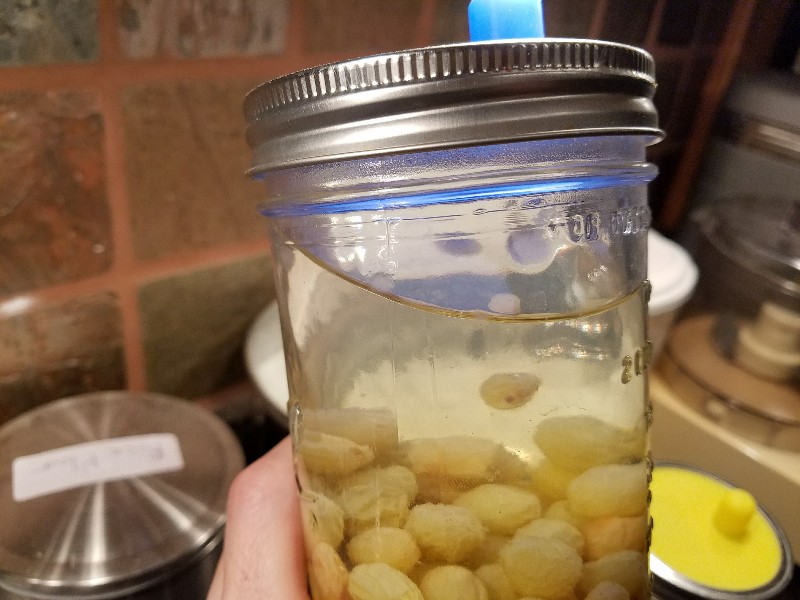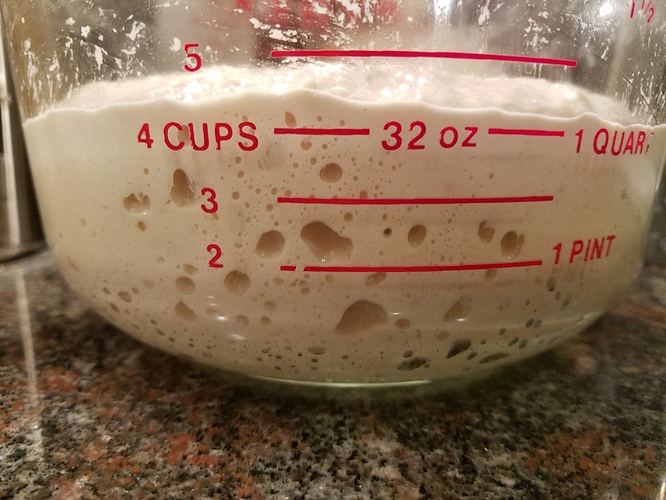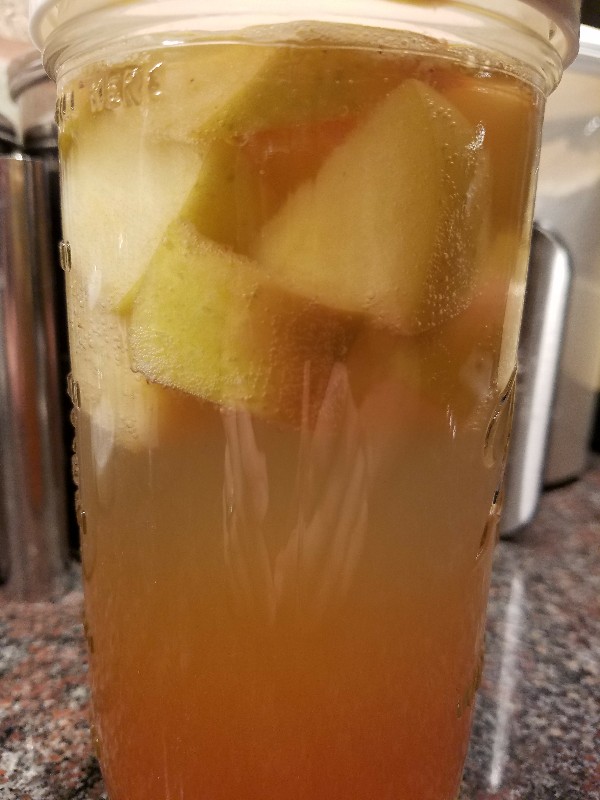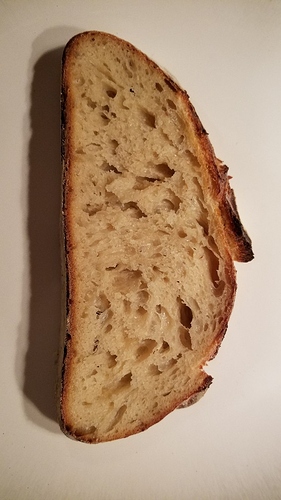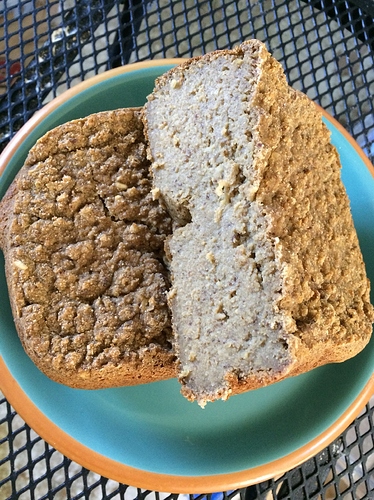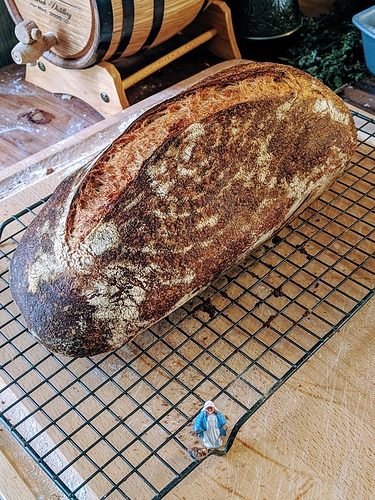You do get a quicker and better rise when used along with sourdough starter. I think that there is a detectable difference in taste with a bit of fruit undertone. As far as using the juice from fermenting vegetables it would work but there would be more lactic acid bacteria present and would impart more of a sour note. Just make sure you want your bread to taste of say sauerkraut before adding the juice. The reason I started using yeast water was to get a lighter crumb in my whole or mostly whole grain breads and it does.
Stu
I have an apple tree so they are ready now. I’ll make some fermented water today and make the bread end of the week. Thanks for that.
Stuart,
Thanks for the clarification on feeding the existing yeast water. I had kinda forgot that I’m not trying to add new yeast from the skins of the feeding fruits.
Last night I chucked the raisin water because mold won over yeast.
I opened and used the date water. About 1 cup in a 500g flour dough. It’s proofing in the fridge now. I wanted to see how it does with no sourdough starter help. 10 hrs in 76-77 F room got me to this lovely state.
After mixing the dough last night, I fed the remaining 1 cup of yeast water with 2/3 an apple (I was hungry so I got the last 1/3) and 1 cup filtered water. I left it overnight on the counter because I was somehow worried. Lol. Look at all these bubbles by this morning.
It’s in the fridge now. 
Thank you again for all your help. I’ll post about the finished loaf tonight or tomorrow morning.
It does look like you have a good culture going. I will look forward to your baking results. Too bad about your raisin one but those things happen.
Stu
gillpugh,
Good luck with your ferment.
Stu
Here’s the final results, a loaf with 500g of white flour, a combination of bread and all-purpose; and 260g date yeast water and 115 regular water. The crumb is very soft and a bit sweet from the date yeast water. I’ll definitely do this again and use some whole grain flour.
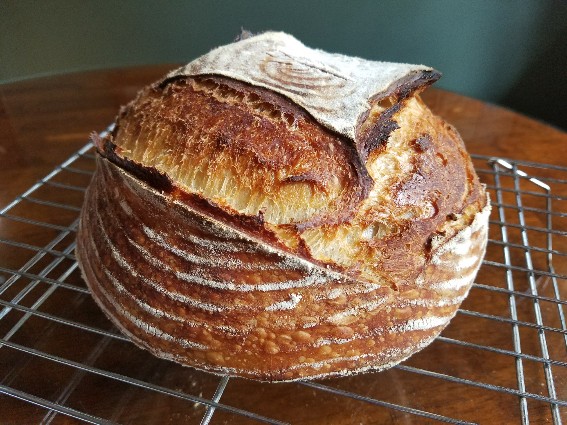
That’s fantastic. I’m going to start this on weekend when I get some time.
Are you using dried dates ? I have both dried dates and dried figs…will definitely be giving this a try !
Yes, they were dried dates.
The key thing is that the raisins, dates, currants etc have not been treated with an antimicrobial like sulphur dioxide.
Raisins are on the dirty dozen list of the Environmental Working Group for pesticide laden produce. Probably why the raisins didn’t yield results, so organic would be a must. Other fruit on the list are:
Nectarines
Peaches
Apples
Strawberries
Peppers
On an additional note, potatoes are on the list also.
Hi, I am new here and also new to baking bread (in a bread machine). I had the hard time baking gluten-free bread: 1. poor crumb texture, not airy, too dense and heavy, silky like cake, 2. little or no rise (use baking soda AND yeast)… only taste is fair. So this thread of discussion seems to give me some light and hope for my ongoing adventure of bread baking. Due to my health condition, I need to switch from regular bread to not only gluten-free but also dairy free, egg free, soy free and nut free bread. I reckon the only way to achieve this would be homemade and so my adventure started but failed immediately and continuously. I also homemade water kefir and now reading your discussion makes me wonder why not use my water kefir to pump up a little on my GF bread baking? Do you guys think it will help like your fermented fruit water? Thanks
I’m sorry to hear you’re dealing with so many dietary restrictions. I can imagine it’s hard to find food/meals that work.
Yeast water will probably not hurt any of your recipes and could possibly help. It won’t turn potato starch into wheat gluten, but I imagine your expectations aren’t for a sky-high fluffy bread.
I assume you’re using commercial yeast already in your GF breads? Wikipedia’s article on “yeast” says fruit-skin yeast is not the same species, which is interesting, but I’m not sure if the impact of using each or both is different. Saccharomyces cerevisiae is the baking yeast. Saccharomyces exiguus (S. minor) is the wild yeast on fruits, according to wikipedia.
Anyhow, the fruit yeast water adds some interesting flavor imo.
A while back, I wrote up a GF Fermented Buckwheat bread recipe. Here is the link. Make sure to look in the comments for quinoa variations. And you’ll want to skip the pumpkin and/or flax seeds if you’re allergic to them – no real impact on final product, just added flavors, textures and crust decor.
Hi Melissa,
I am so glad and grateful receiving your reply. Your sympathy for my dietary issue made me feel and hope better. Thank you.
Yes, I have used SAF yeast (gold) in my GF bread making in a bread machine. But it has yielded poorly in terms of “rise” effect. As I said, I am not even a cook… just now have to start preparing most foods I eat myself, as homemade. In such a short time of change and so much info online, I am crippled in the sense of making all things right and not mentioning to enjoy them. In short, all I know is just that I need lot of probiotics to heal my health condition. But “milk” kefir is in my ban list, I dig a bit and found/bought water kefir grain (to make water kefir) and veggie starter culture (to ferment veggies, e.g., sauerkraut). I still need to dig more to find out what species are in these starters. AW, now I am excited and hopeful knowing from you that I could use water kefir to help baking my GF bread. I’ll try at this week’s bread baking.
Also very happy to read your GF Fermented Buckwheat bread recipe. The loaf in the picture looks marvelously wonderful! If I have the way to bake it, I’ll certainly do it from now on… and never change to anything else. But I don’t so only back to what I did and continue to try improving… BTW, my GF bread ingredients call for: brown rice flour, coconut flour, tapioca flour/starch, sweet potato flour, and oat meal. Other ingredients include coconut cream (as sub for milk), flax seeds (as sub for egg), psyllium husk, sugar, salt, apple cider vinegar, baking soda, water, and SAF yeast. What do you think about my recipe ingredients, especially flours? I plan to replace 1 cup of water with my water kefir at next try. Do you think buckwheat flour is as good as buckwheat groats (nutrition-wise) for bread baking? I may add/replace bk flour in my recipe. Thanks for your advice.
Keep an eye out for some GF news from Breadtopia in the coming weeks.
If you are not on our mailing list, you can sign up here.
Hi, My experiment with water kefir baking GF bread was done yesterday. The result: successful only in the sense of baking a cake, not a bread; also very satisfactory in the tasting as wonderful flavor (due to the water kefir?) cast in the loaf and crumb texture silky and moist; failed in rising and airy structure though. I had used many ingredients for this “cake” including 5 GF flours plus other special dietary substitutes (coconut cream for milk, flax seed for egg, psyllium husk for gruten, and water kefir for yeast and baking soda). Will continue to refine/revise the recipe for any further improvement. Also appreciate your suggestion and advice. The pictures of my GF “cake”:
2018-04-20 20.59.54.jpg
2018-04-21 10.46.48.jpg
Hi, Pictures are not showing in my post. I wonder how can I upload picture files to my post? Any help?
see if this helps:
New to bread making but been brewing awhile. Pulling yeast off fruit is something Brewers do all the time to make sour beer. I’m on a quest to use some of my Brewers techniques in beer.
